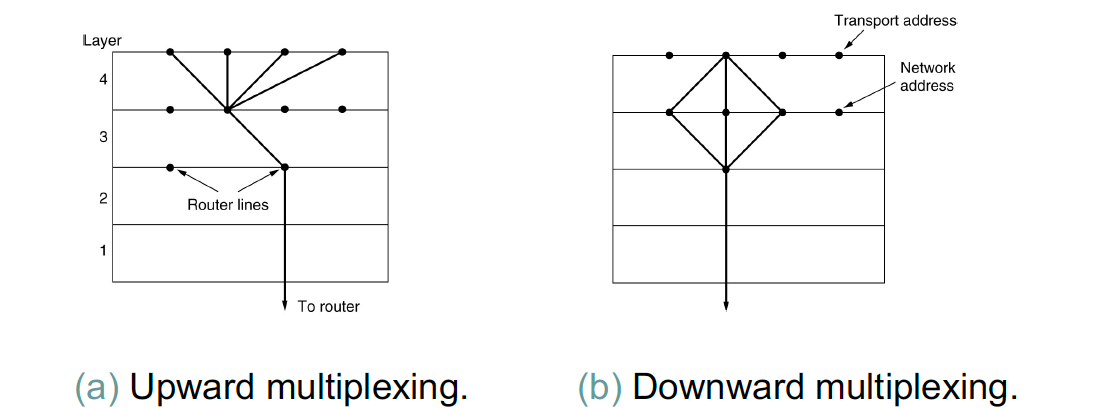CS3311 计算机网络
ch1 计网体系结构
计算机网络概述
- 组成部分
- 工作方式
- 边缘部分
- 用户直接使用
- C/S
- client-server
- * B/S: brower-server
- client-server
- P2P
- 核心部分
- 边缘部分
- 功能组成
- 通信子网
- 资源子网

- 性能指标
- 速率,带宽,吞吐量
- 时延
- 发送/传输~,传播~,排队~,处理~
- 时延带宽积 -> 容量
- RTT 往返时延
- 发送方发送 -> 发送方接收到确认
- 利用率
体系结构&参考模型
计算机网络的各层及其协议的集合
- 7层OSI模型(法定标准)
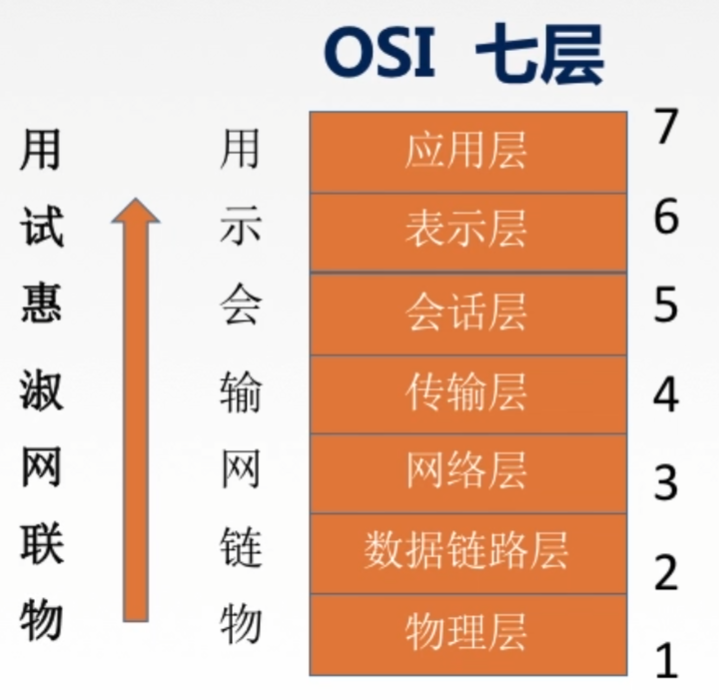
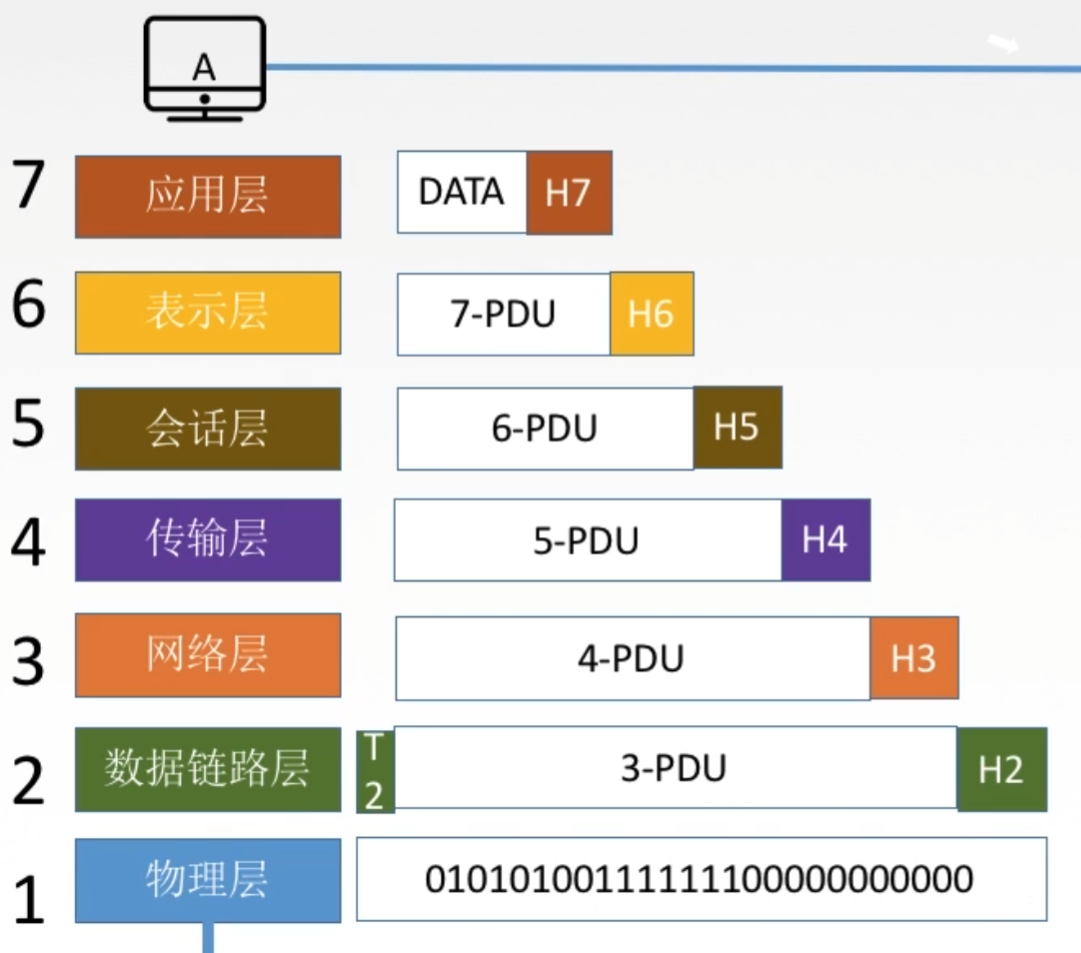
- 4层TCP/IP模型 (事实标准)
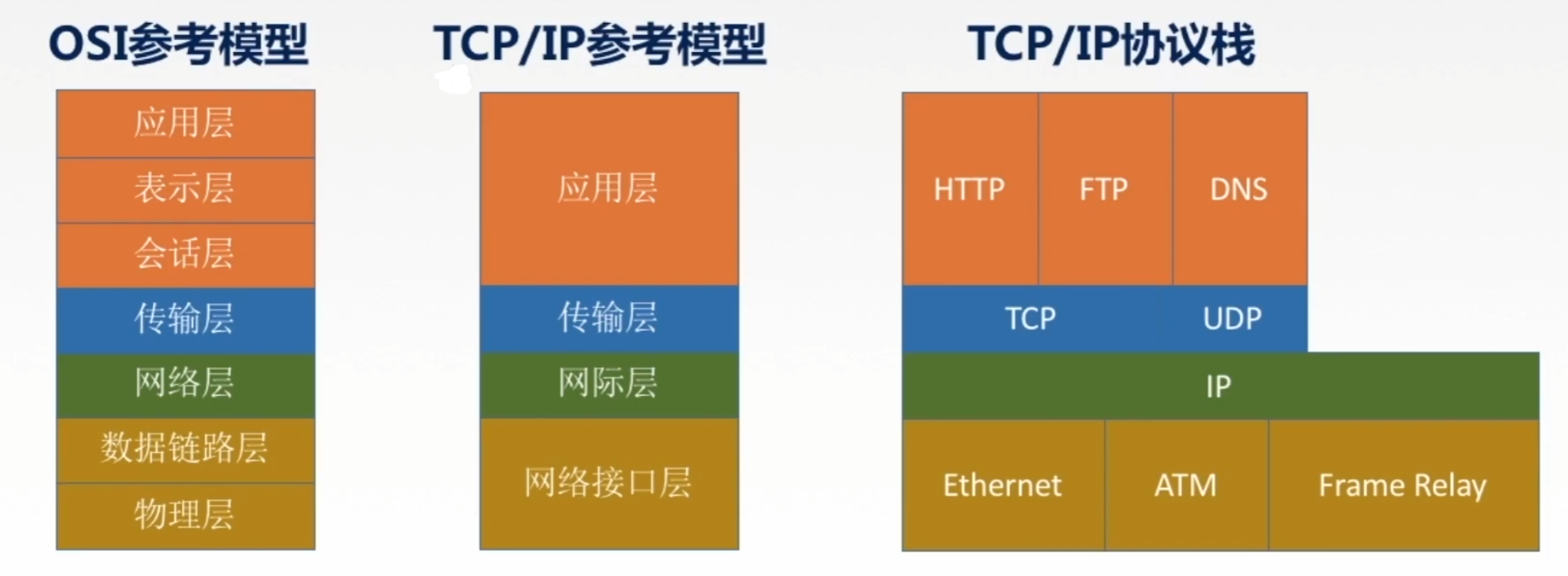
ch2 应用层
Application architecture
- Client-server
- P2P
- hybrid of client-server and P2P
- Skype: centralized server to find address of remote party, then client-client connection
Sockets:进程与计算机网络之间的接口
transport service 一些指标
- data loss
- delay
- throughput
- security
Internet transport services
- TCP
- connection-oriented: 需要先建立连接
- reliable transport
- flow control: 发送的消息不会overwhelm接收方(对于接收方)
- congestion control: 控制网络不会拥堵(对于网络)
- UDP
- use packet-switch
- unreliable data transfer
- TCP
Process identifier = IP address + port number
DNS
- DNS (Domain Name System): map
www.sjtu.edu.cn—>202.120.2.119- distributed, hierarchical database
- root name servers
- TLD (top-level domains)
- Local name server: Client needs to be configured with local name server manually or via DHCP.
- 找到DNS name的方法:iterated query
- 先local DNS server,然后让local DNS server去找:root DNS server,TLD DNS server,authoritative DNS server
- 找到DNS name的方法:recursice query
- 先找local DNS server,然后local DNS sever找root DNS server,然后root DNS server找TLD DNS server,然后TLD DNS server找authoritative DNS server。
Web and HTTP
WWW
client/server model with http
- 首先用DNS把url转换成IP address
- 建立tcp connection
- 发送http request
- 等待http response
- fetch embedded resources
- 清除闲置的tcp connection
HTTP
Hyper Text Transfer Protocol
- 使用TCP,先建立TCP连接,然后用http发送请求
- http是stateless的:不维持状态
cookies:server在client那里drop一个cookie,保存着server state。然后每次client发消息,就把之前的cookie一起发给server。相当于给client配了一个id,然后server可以在数据库里记录client的情况
HTTP Performance: Page Load Time (PLT)
- Round Trip Time (RTT):
- time for a small packet to travel from client to server and back. 一个来回叫一个RTT
- Page Load Time (PLT):
- one RTT to initiate TCP connection
- one RTT for HTTP request and first few bytes of HTTP
- file transmission time
- total = 2RTT + transmit time
- Round Trip Time (RTT):
- Nonpersistent HTTP:
- one object sent over one TCP connection,每次发都要新建一个新的tcp connection
- PLT = N*RTT + transmit time
- Ways to decrease PLT
- 同时并行发多个http请求
- 尽量用persistent http
- move content closer to client
- SPDY,一种更快的web protocol
- web cache (proxy server)
- 目标:不用server,加个cache就行(中间环节)
- browser直接发request到cache,如果有则拿,没有的话cache再向server请求
- cache acts as both client and server
- conditional GET:cache在发GET给server的时候,加个modify的date,如果date不一样,那server就返回新的data。否则就不用返回新data,回一个304 not modified。
- content delivery networks:client接收完内容后,再把内容发给其他server和cache。这样下次别人要用可以直接拿cache和server里的。
FTP
- Client-server model
- 有两种connection,分开的:
- TCP control connection,是persistent的
- TCP data connection,每个文件都要新开一个connection,是non-persistent
- FTP server maintains “state”: current directory, earlier authentication
Electronic Mail
email是怎么做到receiver不在的时候我们的mail也能发到呢?
- 四个部分
- user agents
- mail servers
- transfer protocol (SMTP) ,服务器之间发送email
- access protocol (POP3, IMAP),从服务器拿取email
P2P applications
P2P挑战:
- No servers on which to rely: Communication must be peer-to-peer and self-organizing, not client-server. 必须自己调度!
- Limited capabilities: How can one peer deliver content to all other peers? 一个人要发很多人怎么办?
- Decentralized indexing: How will peers find content,find each other? 怎么找到其他人?
- Participation incentives: Why will peers help each other? 为什么要互相帮助?
Distributed Hash Table (DHT)
- Circular DHT: 每个peer只知道后继节点的ID. $ID(peer)=hash(IP, port)$
- key look up: 平均$O(N)$的复杂度
- key look up with shortcuts: 每个peer也维持一些shortcut,可以降到$O(logN)$
- DHT Finger Table: chap2-2, P25
- peer leave and join: 每个peer记住它后面两个节点,定时ping一下看看在不在,第一个节点走了的话,就让第二个节点把它的后面节点发过来。
BitTorrent Protocol
- 选一个要接收的文件,和tracker请求peer list,然后和peer们进行传输
- tit-for-tat: 一报还一报。过程:
- alice给bob乐观地来点加速,alice成为bob的top 4
- bob回报alice,bob也成为alice的top 4
- Trackerless BitTorrent: 用DHT来标记文件和peer
- P2P Case study: Skype
- hierarchical overlay with SuperNodes
- 问题:alice和bob都在NAT之后
- 解决方法:
- Alice and Bob connectwith their SNs.
- Relay is chosen. Each peer initiates session with relay.
- Peers can now communicate through NATs via relay.
Socket programming with TCP/UDP
什么是socket:a door between application process and end-endtransport protocol (UDP or TCP) 应用层和传输层的桥梁
server和client得有一个socket number
- socket用port number和IP进行区分
需要connection的socket(TCP):
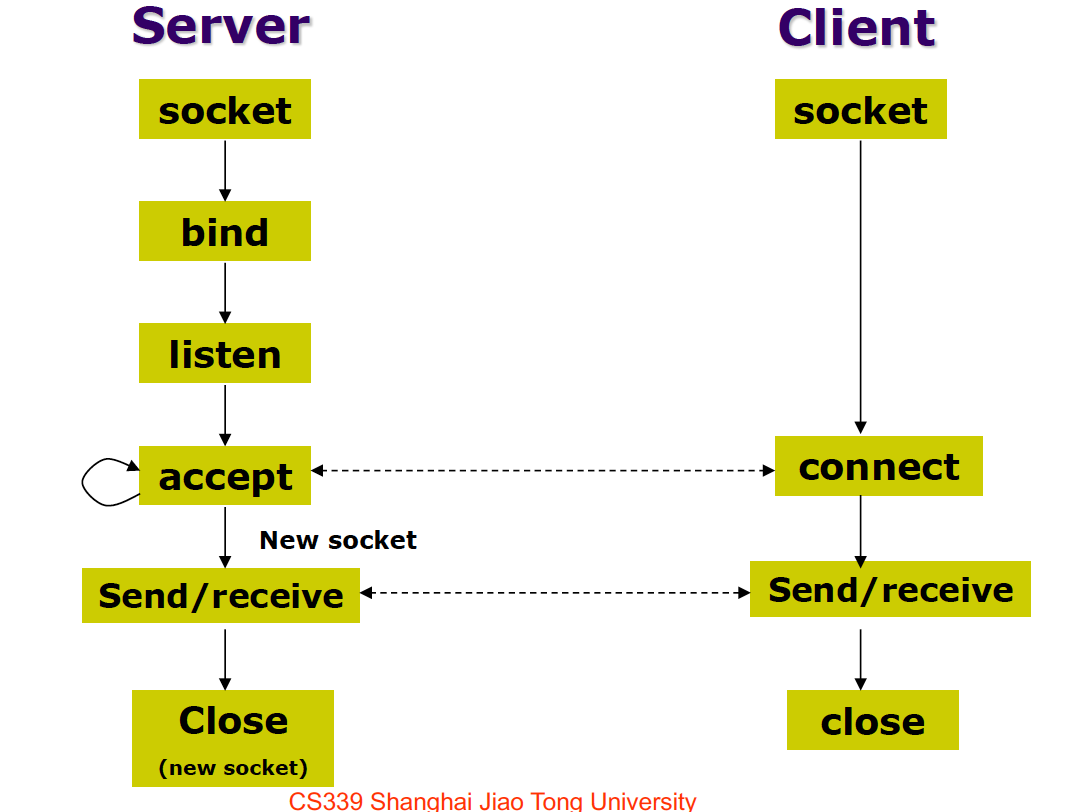
- 不需要connection的socket(UDP):
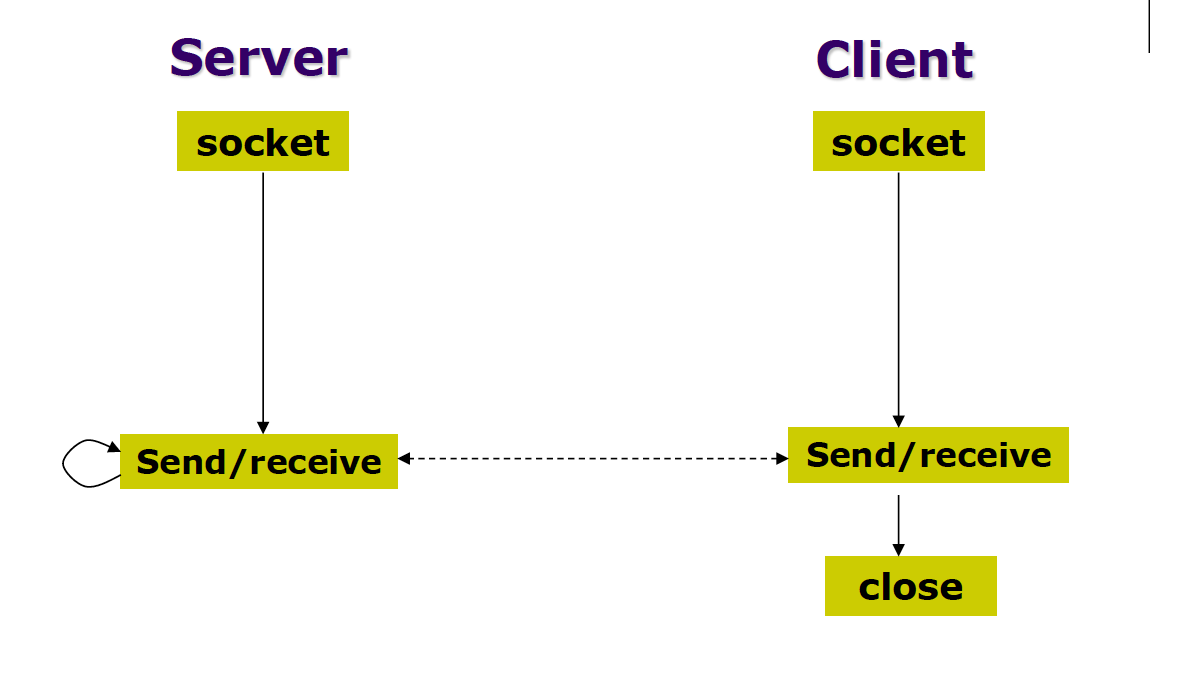
ch3 传输层
单位:segment
提供进程间的数据传输服务
- 软/硬件 = 传输实体 entity
- (网络层:主机间)
- 复用和分用
- 差错检测

Segment (Transport layer) -> Packet (Network layer) -> Frame (Datalink layer)
Multiplexing and demultiplexing
- Ports: server的port选的比较well known,client的port选的比较ephemeral(随意?)
Upward multiplexing和downward multiplexing,看个图就明白了

Multiplexing/demultiplexing: 先把所有socket的数据都合起来发出去,再在接收方那里解开,分到不同的socket。
Given m data bits, generator polynomia- of degree r G(x):
- Append
rzero bits to the low-order end of the frame- (it now contains
m + rbits. )
- (it now contains
- Divide the
m + rbits withr + 1bit string corresponding to G(x) using modulo 2 division- (no carries for addition or borrows for subtraction. Both addition and subtraction are identica- to exclusive OR).
- The remainder is the
rbits CRC.
- Append the
rbits to themdata bits into am+rcodeword which is divisible (modulo 2) by G(x). - When the receiver gets the checksummed frame, it tries dividing it by G(x). If there is a remainder, there has been a transmission error.
两个主要协议
- UDP 用户数据报协议
- 提供无连接服务
- 对方的运输层在收到UDP报文后,不需要给出任何确认
- 单位:UDP用户数据报
- 低时延,小文件适用
- TCP 传输控制协议
- 无连接
- 不保证可靠交付
- 可能发生lost,error,out of order (可在应用层增加可靠性)
- 面向报文
- 适合一次性传输少量数据
- 实时传输,无拥塞控制
首部开销小
首部格式
8B,由4部分构成

- UDP长度:数据报差别
检验和:检测是否出错
分用如果找不到目的端口,则由发送方发送不可达信息(ICMP)
UDP校验
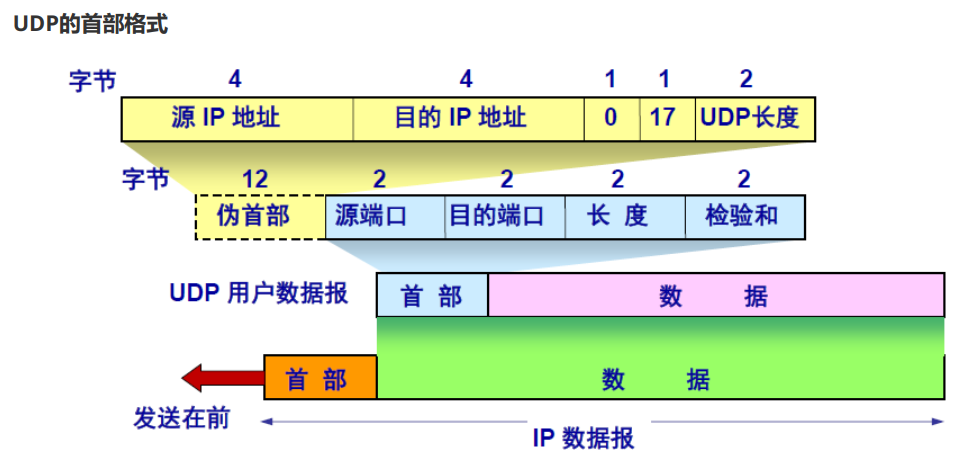
- 伪首部只用于计算检验和,不向下传送也不向上递交
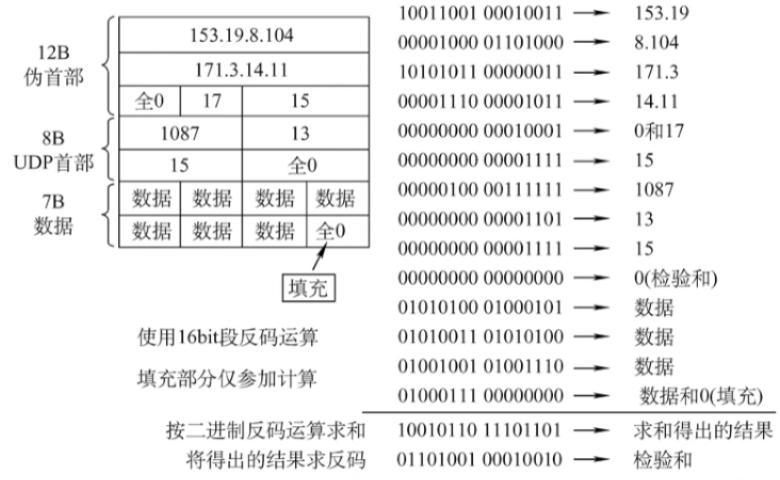
- 具体步骤(发送端)
- 填上伪首部
- 全0填充检验和字段
- 全0填充数据部分
- 伪首部+首部+数据采用二进制反码求和
- 和求反码填入检验和字段
- 去掉伪首部并发送。
- (接收端)
- 填上伪首部
- 伪首部+首部+数据采用二进制反码求和
- 结果全1则无差错
主要特点
- UDP是无连接的
- UDP使用尽最大努力交付
- UDP是面向报文的
- UDP对应用层交下来的报文,既不合并,也不拆分,而是保留这些报文的边界
- 应用程序必须选择合适大小的报文
若报文太长,IP层在传送时可能要进行分片
若报文太短,会使IP数据报的首部的相对长度太大 - UDP没有拥塞控制
因此网络出现的拥塞不会使源主机的发送速率降低 - UDP支持一对一、一对多、多对一和多对多的交互通信
- UDP的首部开销小,只有8个字节,比TCP的20个字节的首部要短
Why UDP?
- no connection establishment (which can add delay)
- no retransmission (which can add delay)
- simple: no connection state at sender, receiver
- small segment header: 8 bytes
- no flow control and congestion control:
- UDP can blast away as fast as desired
TCP
Go-Back-N (GBN):
- 发送方: GBN是一种滑动窗口协议,发送方可以连续发送多个数据帧,直到达到窗口大小为止。发送方会等待收到对窗口内所有数据帧的确认,然后才能发送下一个窗口的数据帧。
- 接收方: 接收方按序接收数据帧,如有帧丢失,就会回退(Go-Back)并重新请求所有未确认的帧。
- 接收方丢弃所有失序分组
- 优点:接收方只需要缓存一个包就行,不需要缓存失序分组
**Selective Repeat (SR):
- 只重传那些没有正确ACK的包
- 发送方和接收方都维持相同大小的window size。接收方把接收到的都buffer住。
- $sending\ window + receiving\ window \leq MAX\ SEQ+1$
- 发送方: SR也是一种滑动窗口协议,允许发送方同时发送多个数据帧。与GBN不同,发送方只需要重传丢失的帧,而不是整个窗口。
- 接收方: 接收方按序接收数据帧,并确认它们。即使有帧丢失,接收方也会继续按序接收后续的帧。
Transmission Contro- Protoco- (TCP):
- 特点: TCP是一种面向连接的协议,提供可靠的、有序的数据传输。它使用滑动窗口协议,但其设计更为复杂。TCP包括流量控制、拥塞控制、连接建立和断开等多个功能。
- 连接建立: 通过==三次握手==建立连接,确保双方都准备好进行通信。
- 累积确认: TCP使用==累积确认==的机制。这意味着如果接收方成功接收了某个字节之前的所有字节,它只需确认最后一个字节,而不必逐个确认每个字节。
- 累积确认号和确认标志:
- TCP报文头部中的确认号字段指示下一个期望接收的字节。
- 确认标志(ACK标志)用于指示报文是一个确认报文。
- 滑动窗口:
- 使用滑动窗口来控制发送和接收的数据量,以提高网络利用率。
- 可靠性:
- 提供==数据确认==、==重传==机制以确保数据的可靠传输。
- 流量控制和拥塞控制:
- TCP包括流量控制机制,防止快速发送方淹没较慢的接收方;包括拥塞控制,以应对网络拥塞情况。
TCP congestion control
congestion control: open loop, closed loop
- Congestion Avoidance:提前预测,及时避免,主要两种方法
- host centric:TCP congestion control
- Router-centric: warning bit, choke packet, load shedding
- AIMD: Additive Increase, Multiplicative Decrease
- MD: decrease window by factor of 2 when loss,减少的时候一下子除以2
- AI: additive increase until packet loss,增加的时候一个个加
- Explicit Congestion Notification:
- 直接通知堵塞的packet的sender
丢包判断:
- time out
- 连续3个duplicate的ACK
- TCP Tahoe/Reno implements AIMD to limit the sending rate.
- Sender uses packet loss as the network congestion signal.
- TCP use a Congestion Window (CongWin) next to the window granted by the receiver.
- The actual window size is the minimum of the two.
- Self-clocking: The CongWin size should be adjusted frequently, to match the networking carrying capacity
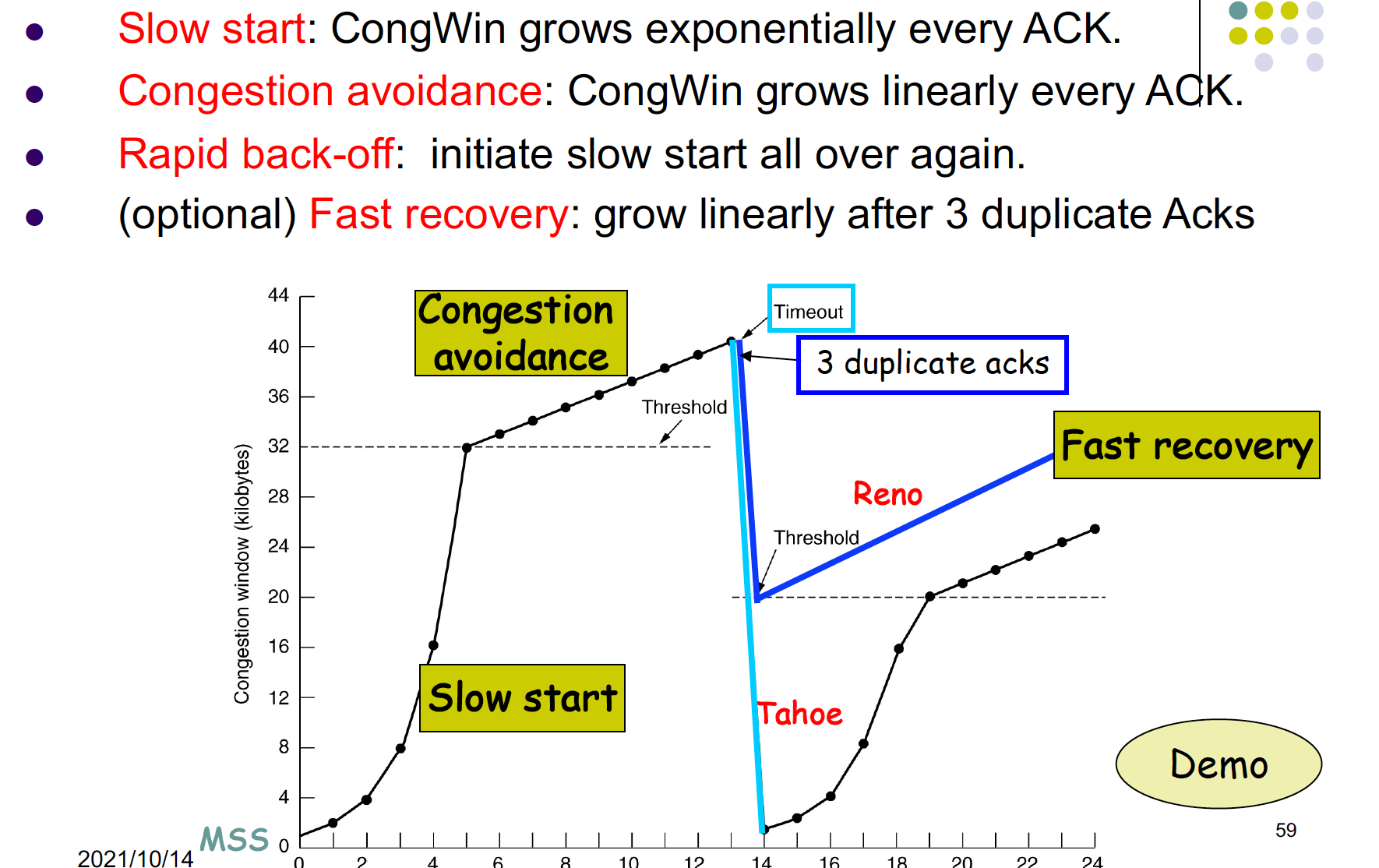
端口
- 虽然通信的终点是应用进程,但只要把所传送的报文交到目的主机的某个合适的目的端口
TCP/IP的运输层用一个16位端口号来标志一个端口,端口号只具有本地意义
服务端
- 熟知端口号 0-1023
- 登记端口号 1024-49151
- 客户端
- 仅在客户进程运行时才动态选择
- 49152-65535
- 套接字 = IP + 端口号
- IP确定主机
- 端口号确定进程
ch4 网络层
主要任务:把分组从源端传输到目的端,为分组交换网上的不同主机提供通信服务 allow packets to be sent between any pair or hosts

路由器的工作:
- routing: determine route from source to dest; determine the output link.
- forwarding/switching: move packets from router’s input to appropriate router output
- congestion control: drop packets, update routing table
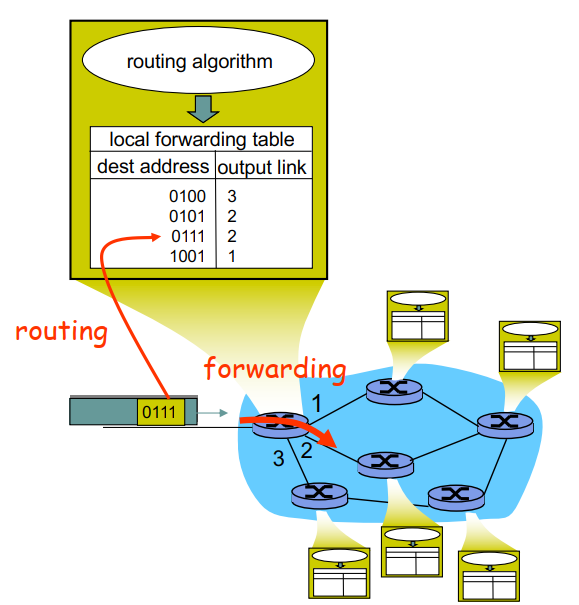
IP service model:
- Datagram 数据报
- Unreliable
- Best effort
- Connectionless
- No per-flow state, might mis-sequece packets
Virtual-Circuit and Datagram Switching
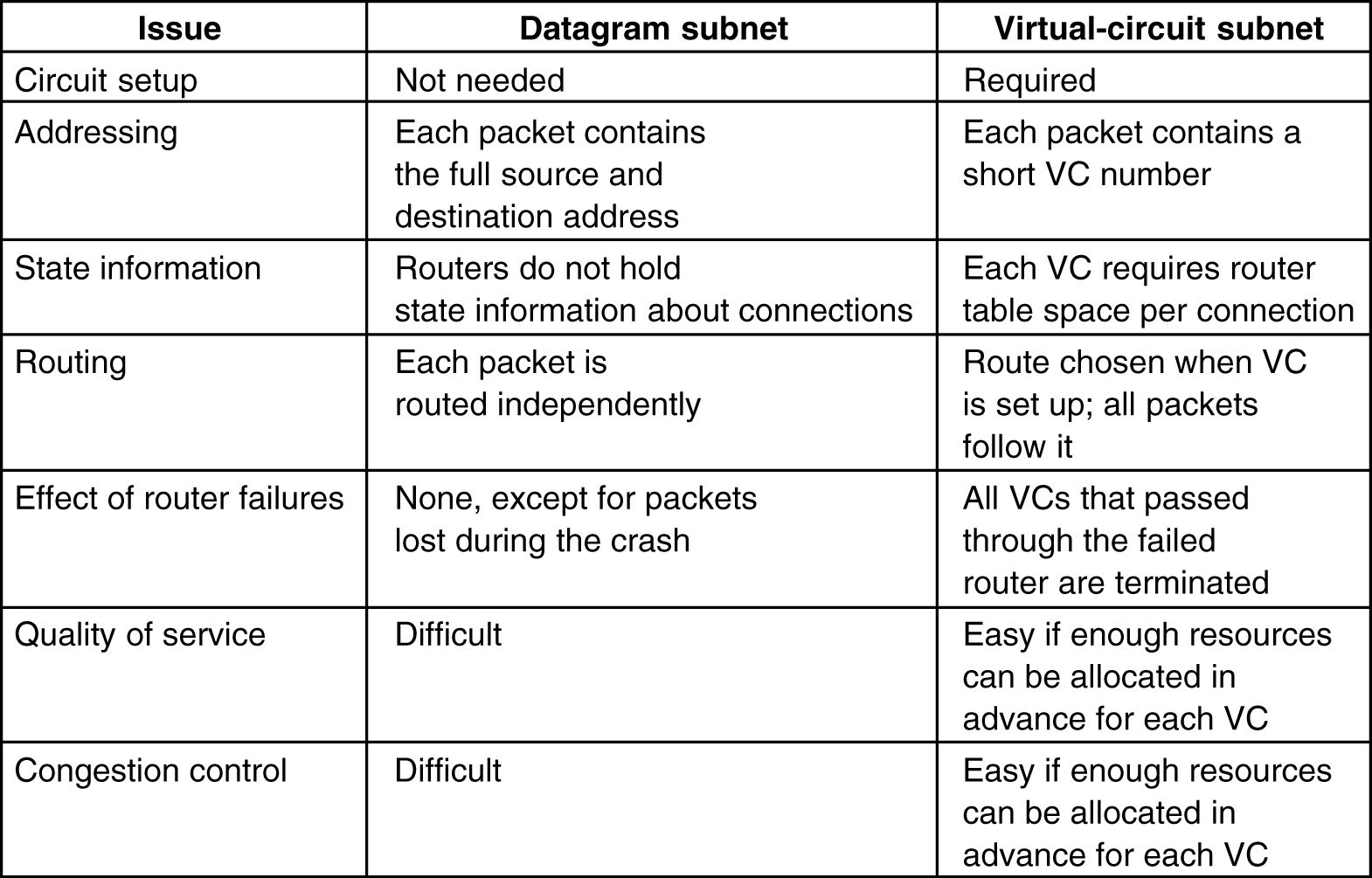
Datagram Switching
- destination address as the index of forwarding
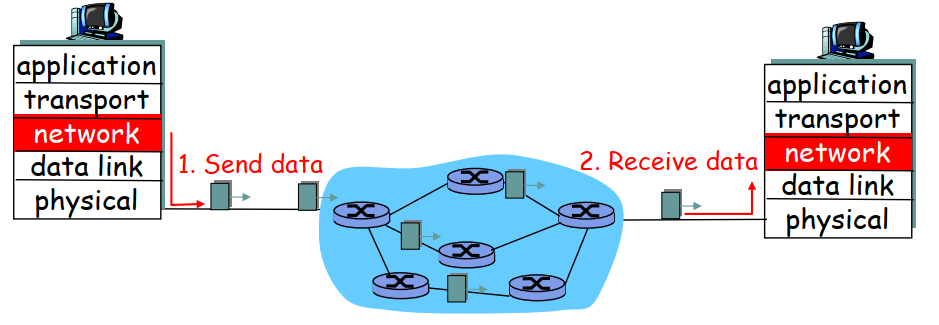
- Forwarding table 转发表
- Longest Prefix Matching
- 减小转发表长度
Virtual-Circuit
VC consists of:
- path from source to destination
- VC numbers
- entries in routers along path
packet carries VC number (rather than dest address) as the index of forwarding
转发表示例:
| incoming interface | incoming VC# | outgoing interface | outgoing VC# |
|---|---|---|---|
| 1 | 12 | 3 | 22 |
| 2 | 63 | 1 | 18 |
| 3 | 7 | 2 | 17 |
| 1 | 97 | 3 | 87 |
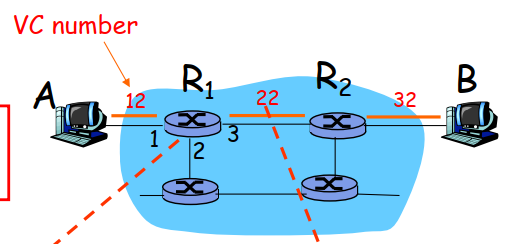
Router architecture
- Four parts: input and output port, routing processor and switching fabric.
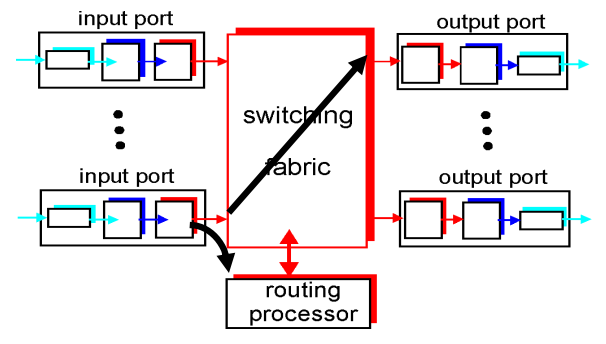
Two key router functions:
- run routing protocol
- RIP, OSPF, BGP
- forwarding datagrams from incoming to outgoing link
Input Port Queuing
- Head-of-the-Line (HOL) blocking:
- queued datagram at front of queue prevents others in queue from moving forward
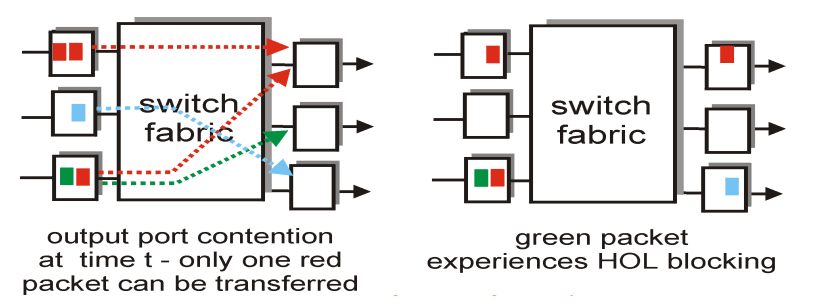
Output Port Queuing
- buffering when arriva- rate via switch exceeds output line speed
- queueing (delay) and loss due to output port buffer overflow!
Packet Scheduling
Scheduling:
- chooses among queued datagrams for transmission
- fair queuing
- weighted fair queuing
IP: Internet Protocol
Datagram format
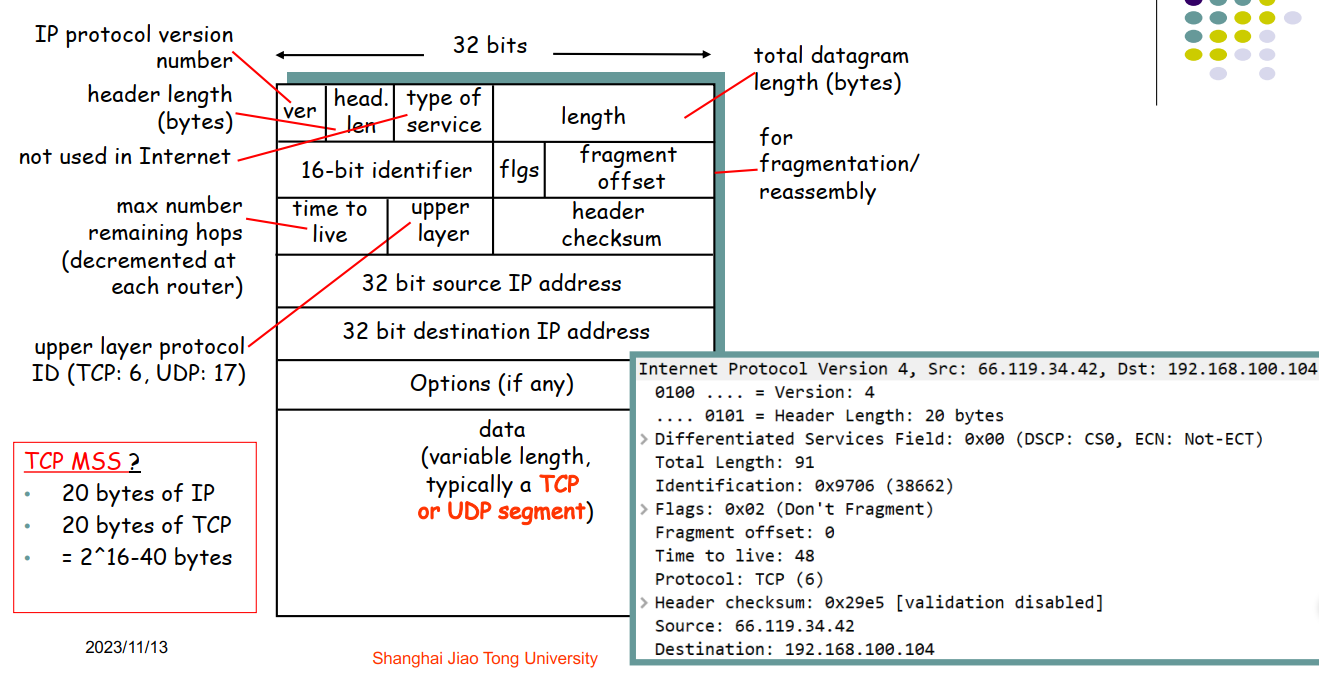
IP Header TOS
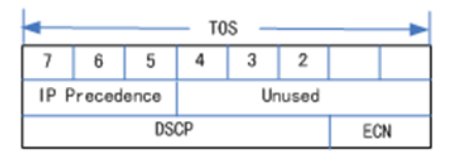
IP Fragmentation and Reassembly
- Network links have Maximum Transmission Unit (MTU)
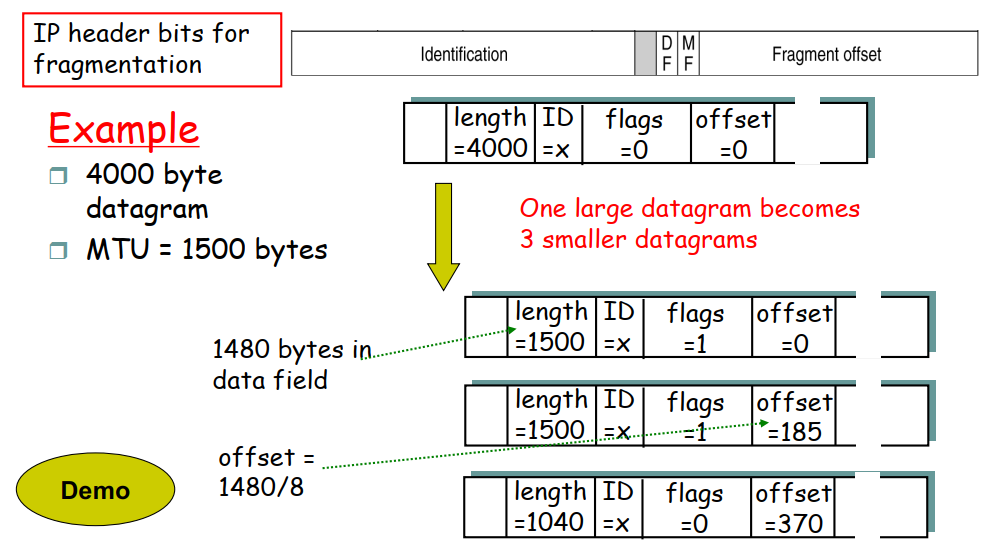
IPv4
- Classfu- IP addressing
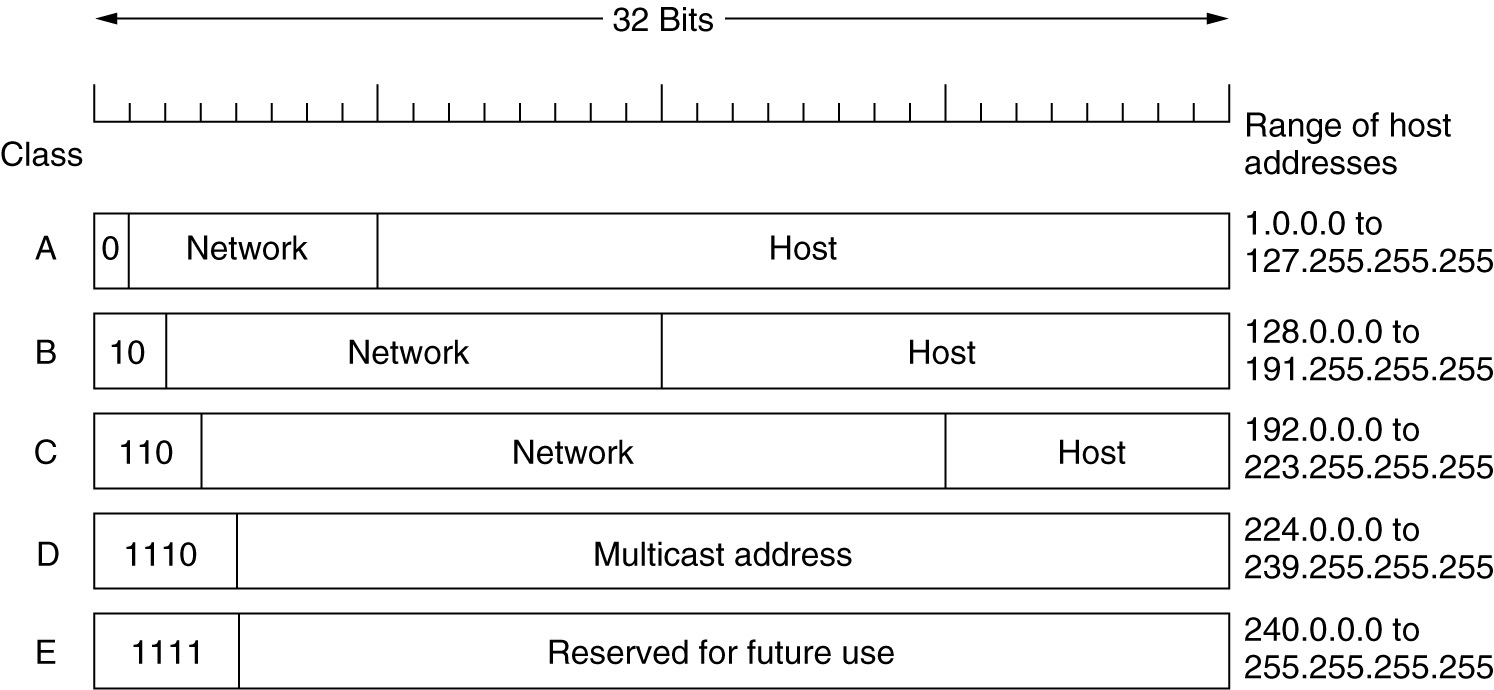
- Specia- addresses

| Class | Address |
|---|---|
| A | 10.0.0.0 - 10.255.255.255 |
| B | 172.16.0.0 - 172.31.255.255 |
| C | 192.168.0.0 - 192.168.255.255 |
Subnetting: dividing an IP network into two or more
networks
VLSM (Variable Length Subnet Mask) 子网掩码
- IP address = subnet id + host id
how to denote subnet mask?
- a.b.c.d/x, where x is # bits in subnet portion of address
- 1 for subnet id bits, 0 for host id bits (e.g. 255.255.255.0)
how to assign IP addresses for the subnets?
- fix subnet part first
- fix host part first
-> Given a class C IP address 223.1.1.0, how to assign IP addresses for the subnets?
- Host first
- Subnet first:
- 6 subnets (>= 8 parts, host ID <= 5 bits)
- -> x = 27
- .32 -> .64 -> .96 … -> .192 (use broadcast address to indicate al- IP under a subnet)
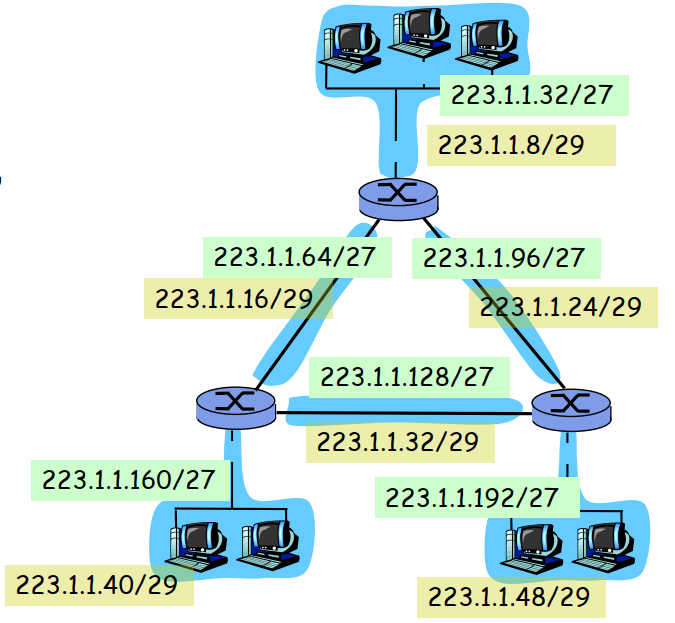
网络地址:表示了整个网络,不能被分配给具体的主机。例如,在子网掩码为/24的网络中,网络地址是第一个地址,即
x.x.x.0,不属于主机地址广播地址: 广播地址用于将数据包发送到网络上的所有主机。例如,在子网掩码为/24的网络中,广播地址是最后一个地址,即
x.x.x.255。
CIDR表示法 Classless InterDomain Routing
- Assign class C addresses in contiguous blocks of 256 addresses so that multiple entries in routing table can be reduced into one
CIDR表示法(a.b.c.d/x)转换为子网掩码通过将所有32位的二进制数中的前 x 位设置为 1,然后将 32-x 设置为 0 来完成。

/26确定了subnet标识符的长度为32位IP地址的前26位- subnet mask的前25位则位1,其余位设置为0,即可得到子网掩码
DHCP
DHCP的工作流程如下:
- 设备连接到网络时,它发送DHCP请求(DHCP Discover)以寻找可用的DHCP服务器。
- DHCP服务器收到请求后,为设备提供IP地址和其他配置信息(DHCP Offer)。
- 设备选择一个提供的配置,并向选择的DHCP服务器发送请求(DHCP Request)。
- 服务器确认请求,设备获得分配的IP地址和配置信息(DHCP Ack)。
通常路由器或无线路由器会集成DHCP服务器功能,以便自动为连接到网络的设备分配IP地址。
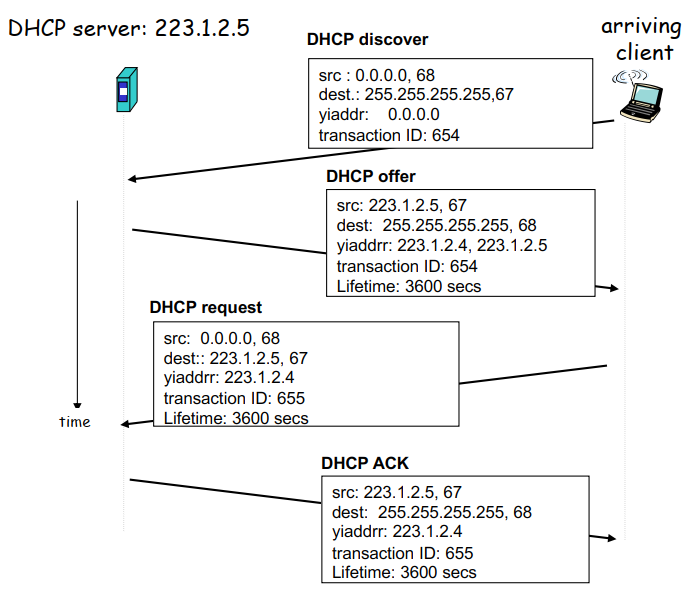
NAT: Network Address Translation
- Motivation:
hosts in LANs use private IP addresses and share one public IP address for Internet access:- handle public IP address shortage.
- can change addresses of devices in LAN without notifying outside world
- can change ISP without changing addresses of devices in LAN
- devices inside not explicitly addressable, visible by outside world (a security plus).
NAT traversa- problem
- solution 1: 静态NAT端口映射在NAT设备上手动配置
- statically configure NAT to forward incoming connection requests at given port to server
- e.g., (123.76.29.7, port 2500) always forwarded to 10.0.0.1 port 25000
端口地址转换(Port Address Translation,PAT)结合使用。在PAT中,多个设备可以共享同一个公共IP地址,但通过使用不同的端口号来区分它们。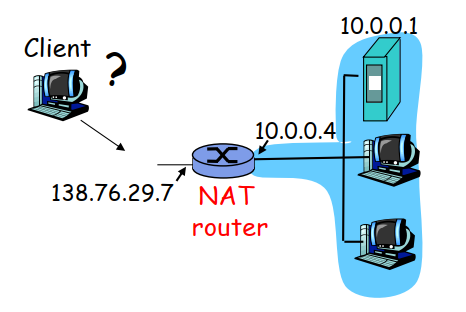
- solution 2: Universa- Plug and Play (UPnP) Internet Gateway Device (IGD) Protocol. NATed主机可以在运行时动态配置端口映射,无需手动干预NAT规则。
- ==automate static NAT port map configuration==
- Allows NATed host to:
- learn public IP address (138.76.29.7) **学习公共IP地址
- NATed主机可以使用UPnP协议获取与NAT设备关联的公共IP地址。这对于NATed主机了解其在互联网上的外部标识是很有用的。
- add/remove port mappings (with lease times) **添加/删除端口映射
- NATed主机可以通过UPnP协议请求NAT设备在路由器上创建或删除端口映射。这意味着NATed主机可以动态配置路由器以允许从外部访问它的服务。
- 映射的端口是由UPnP协议与NAT设备协商确定的,租约时间规定了端口映射的持续时间,一旦过期,NAT设备可以自动删除映射。
- learn public IP address (138.76.29.7) **学习公共IP地址
- Allows NATed host to:
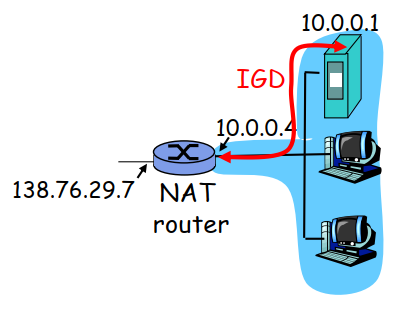
- solution 3: relaying (used in Skype)
- NATed client establishes connection to relay 中继
- Externa- client connects to relay
- relay bridges packets between to connections
在中继方案中,不需要在NAT设备上配置端口映射规则,也不需要NATed客户端能够接收来自外部网络的连接。两方客户端都只需知道中继服务器的公共IP地址进行联络,而不需要直接处理彼此所在的NAT过程。

ICMP (Internet Contro- Message Protocol)
- used by hosts & routers to communicate network-leve- information
- error reporting: unreachable host, TT- exceeded, redirect, Checksum failed etc.
- echo request/reply (used by ping)
- network-layer “above” IP:

| Type | Code | description |
|---|---|---|
| 0 | 0 | echo reply (ping) |
| 3 | 0 | dest. network unreachable |
| 3 | 1 | dest host unreachable |
| 3 | 2 | dest protoco- unreachable |
| 3 | 3 | dest port unreachable |
| 3 | 4 | ==fragmentation needed== [for path MTU discovery] |
| 3 | 6 | dest network |
| 3 | 7 | dest host |
| 4 | 0 | source quench (congestion contro- - not used) |
| 8 | 0 | echo request (ping) |
| 9 | 0 | route advertisement |
| 10 | 0 | router discovery |
| 11 | 0 | ==TT- expired== [for traceroute] |
| 12 | 0 | bad IP header |
IPv6
- Initia- motivation:
- 32-bit address space soon to be completely allocated.
Additiona- motivation:
- header format helps speed processing/forwarding
- header changes to facilitate QoS
IPv6 datagram format:
- fixed-length ==40 byte header==
- extension headers allowed
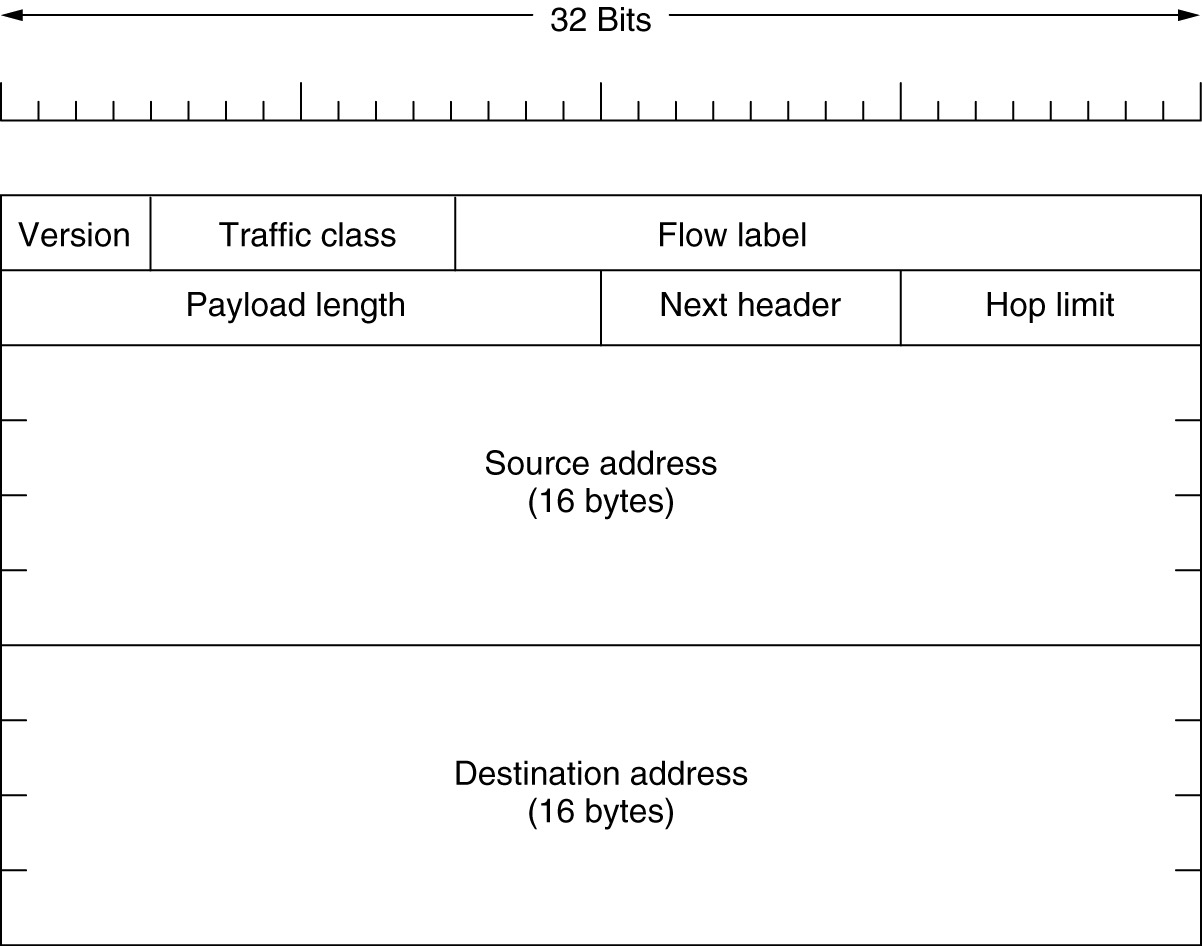
IPv6 Addresses
- The 16-byte IPv6 address is written as 8 groups of 4 hexadecima- digits with colons between
- e.g. FE80::202:B3FF:FE1E:8329
An IPv6 address can be in one of three categories:
- Unicast: A packet sent to a unicast address is delivered to the interface identified by that address.
- Multicast: The packet wil- be processed by al- members of the multicast group.
- Anycast (new to IPv6): The packet wil- be delivered to only one of the interfaces configured for the anycast address — usually to the nearest one.

SDN
数据平面->转发过程
硬件为主
控制平面->路由选择过程(较为复杂)
软件为主
- 传统->SDN
- 传统:路由选择器执行控制平面功能。既进行转发,也维护转发表
- SDN:路由选择处理器负责与远程控制器通信,接受其计算的转发表项
路由选择 Routing
chap4-2
路由选择算法
- static/dynamic routing
Link State Routing (LSR)
Each router learns the entire network topology through
exchanging information with all other routers, and then
calculate least cost path to the other routers.Each router must do the following:
- Discover its neighbors, measure the delay or cost to each of its neighbors.
- Construct a packet telling all it has just learned.
- Flood 洪泛 this packet to all other routers.
- Compute the least cost path to every other router when costs of all the edges learnt
All least cost paths from a given source to other nodes in the network, constitute a sink tree
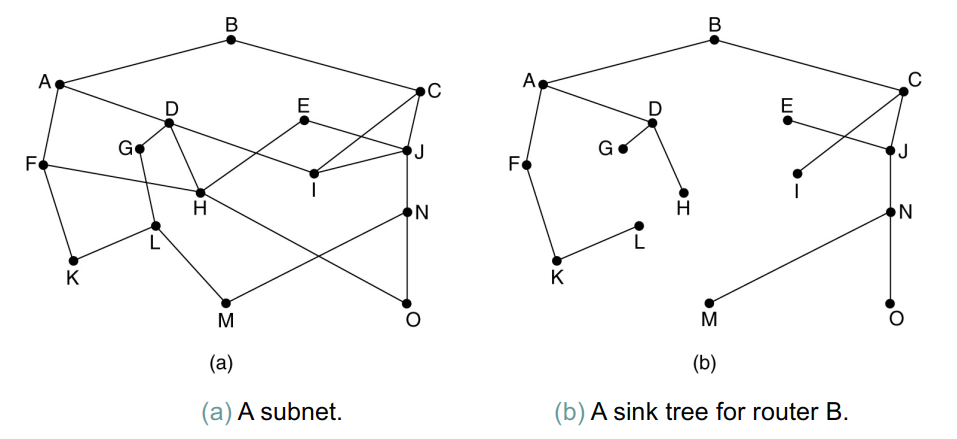
Distance vector routing (DVR) 距离向量路由
eg. 分布式Bellman-Ford路由算法, RIP
Each router maintains a table (i.e Distance Vector) with least
cost/distance to every other routers.Each router must do the following:
- Discover its neighbors, measure the cost to each neighbor v.
- Exchange DV with the neighbors.
- Recalculate DV (the new least cost to every other routers) with the Bellman-Ford equation: $d_x(y) = min (c(x,v) + d_v(y) )$
where $d_x(y)$ is least-cost from x to y, min is taken over all neighbors v of x
DVR “count to infinity” problem
- message complexity: how many msgs sent between all n nodes?
- LS: with n nodes, E links, totally $O(n\times E)$ msgs sent
- DV: exchange between neighbors only, totally $O(n)$ msgs sent
- computation complexity: algorithm for calculating least cost each
- LS: Dijkstra , $O(n^2)$
- DV: Bellman-Ford equation , $O(n)$
- speed of convergence: given a change, how long until the network re-stabilizes?
- LS: 1 iteration. may have oscillations
- DV: n iterations.
- Good news travel fast, but possible count-to-infinity problem for bad news.
- Robustness: what can happen if a router fails or misbehaves?
- LS: robust. Node route calculations are somewhat separated
- DV: an incorrect node calculation can be diffused through the entire network. A node can advertise incorrect least-cost paths to its neighbors and then pass indirectly to its neighbor’s neighbors and then to all destinations.
Hierarchical Routing 层次路由算法
hierarchical routing saves table size, reduced update traffic.
- “autonomous systems” (AS)
- aggregate routers into regions, correspond to an administrative domain 管理域.
- Assigned an unique 16/32 bit number.
- ==intra-AS==/interior gateway routing 内部网关路由
- should find the least cost path as best as possible
- routers in same AS run same routing protocol -> trusted
- routers in different AS can run different intra-AS routing protocol
- ==inter-AS==/exterior gateway routing 外部网关路由
- has to deal with a lot of politics.
- Routers do not automatically use the routes they find, but have to check manually whether it is allowed.
- admin controls over how traffic routed -> untrusted
Broadcast routing
In-network duplication
- flooding: when node receives broadcast packet, sends copies to all neighbors
- Problems: cycles & broadcast storm
- controlled flooding:
- TTL,age
- node keeps track of packet IDs already brdcsted
- reverse path forwarding (RPF):
- only forward packet if it arrived on shortest path between node and source
- spanning tree
- no redundant packets received by any node
Reverse Path Forwarding
- Method: use the routing table reversely. If the broadcast
packet comes from a node which is the next hop to the source,
then forwards copies of it onto all lines except the one it
arrived on, else discards it. - Pros: efficient and easy to implement
ch5 数据链路层
Link layer is implemented in “adaptor” (network interface card NIC) in each host and routers.
Data-link layer has responsibility of transferring datagram from one node to physically adjacent node over a link (node-to-node job)
Functions
- reliable data transfer 可靠传输
- error control 差错控制
- flow control 流量控制
- sharing a broadcast channel: multiple access control
- link layer addressing 封装成帧和透明传输
Functions
- 加强物理层传输原始比特流的功能,使之对网络层表现为无差错链路
封装成帧

- 添加首尾部,构成帧定界
- 帧同步:接收方可以从二进制比特流中区分帧的起始和终止
透明传输
- 不管所传数据是什么组合,都应当可在链路上传输。
- 所传数据的比特组合恰好等于控制信息也不会导致误认。
字符计数法
- 容易出错
字符填充法
| SOH | data | EOT |
|---|---|---|
| Start of header | End of transimission |
- 在数据段内的SOH和ESC前添加转义字节防止误判
- 零比特填充法
每遇到5个1就填充1个0
Two point-to-point Data Link
ProtocolsHDLC – High-Level Data Link Control 高级数据链路控制
- A pretty old, but widely used protocol for point-to-point connections.
- bit-oriented
- PPP – The Point-to-Point Protocol 点到点协议
- Internet standard (RFC1661 1662 1663), is used in the Internet for a variety of purposes, including router-to-router traffic and home user-to-ISP traffic.
- byte-oriented
ch6 物理层
- 信源 - 信道 -> 信宿
通信方式
单工通信
- 单一方向,单一信道
半双工/双向交替通信
- 均可发送和接受,但是不能同时
- 两条信道
全双工/双向同时通信
传输方式
- 串行/并行
同步/异步
- 同步:以数据区块为单位,先送出同步字符
- 异步:以组为单位,加字符起始位和终止位
码元
- 固定时长的信号波形
- M个离散状态 -> M进制码元
奈氏准则
在理想低通条件下,为了避免码间串扰,极限码元传输速率为2W Baud,W为信道带宽,单位为Hz。

香农定理
噪声存在于所有的电子设备和通信信道中。由于噪声随机产生,它的瞬时值有时会很大,因此噪声会使接收端对码元的判决产生错误。但是噪声的影响是相对的,若信号较强,那么噪声影响相对较小。因此,信噪比 (信号的平均功率S/噪声的平均功率N -> db表示 = $10log_{10}S/N$) 就很重要。

编码&调制
- 信号类型
- 基带信号:直接表达了要传输的信息的信号
- 数字信道 -> 基带传输
- 宽带信号:基带信号调制后的频分复用模拟信号
- 模拟信道 -> 宽带传输
- 基带信号:直接表达了要传输的信息的信号
数据 -> 数字信号(编码)
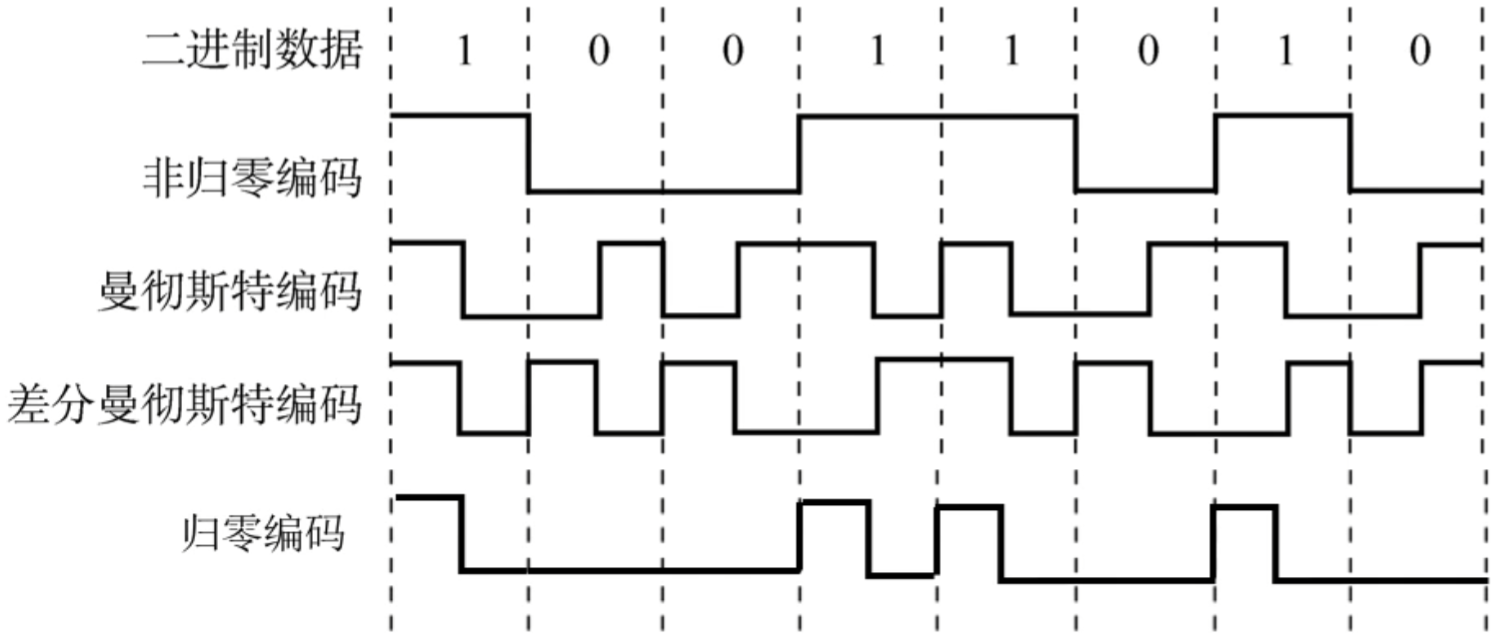
曼彻斯特编码:自同步,但是占用两倍宽度的频带,数据传输速率为调制速率的一半
+差分:同1异0(虚线两侧)。更强的抗干扰性

信号电平翻转表示0
4B/5B:额外插入比特,保留控制码
模拟数据 -> 数字信号
高保真:PCM 脉码调制
f采样频率>=2f信号最高频率
数据 -> 模拟信号(调制)
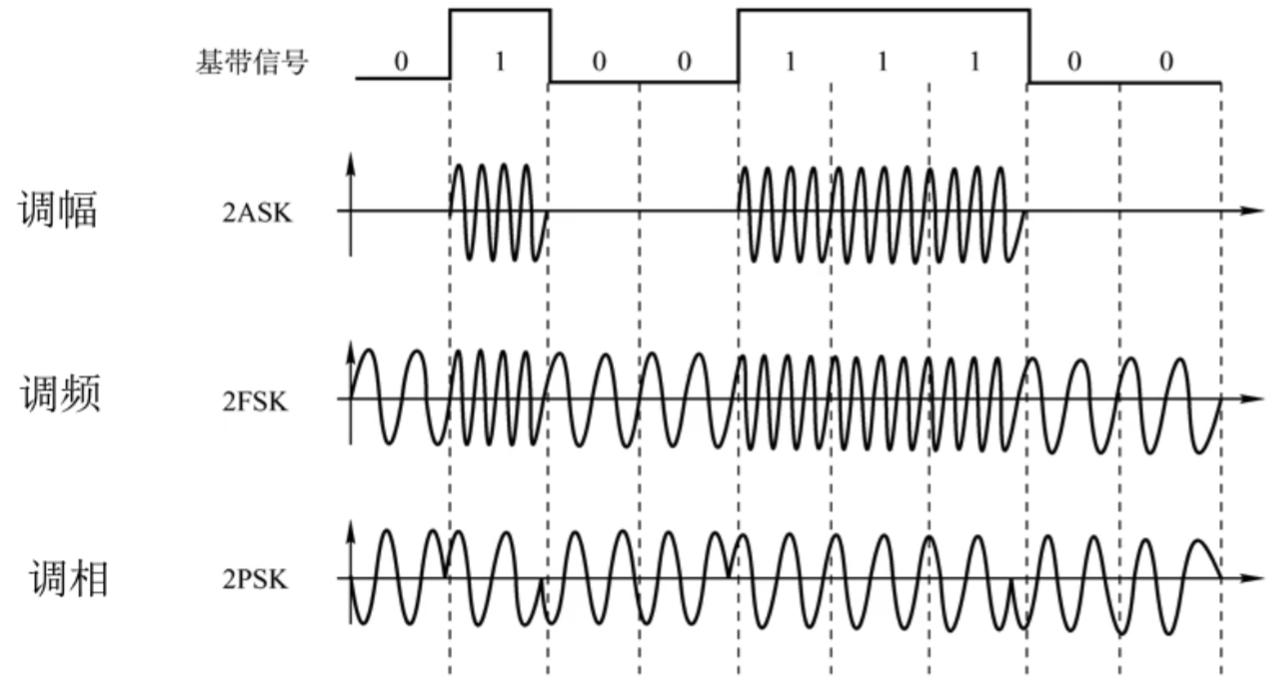
调频+调相 = QAM
可以表示的码元类型为相位类型数*振幅类型数
模拟数据 -> 模拟信号
频分复用
数据交换
电路交换
- 建立连接 -> 通信 -> 释放连接
- 高占用,低时延,建立连接时间长,全双工,控制简单
报文交换
存储转发
- 只适用于数字信号
分组交换
分组后存储转发
数据报方式
- 无连接服务
- 分组多次,不能保证到达顺序
- 每次转发进行验证后删除,有一定时延
虚电路方式
- 连接服务
- 需要携带虚电路号信息
- 顺序保证
传输介质
物理通路
导向性
- 双绞线
- 屏蔽~ STP,非屏蔽~ UTP
- 同轴电缆
- 光纤
- 光脉冲
- 带宽极大
- 实心纤芯 + 包层
- 单模 -> 横向,远距离;多模 -> 易失真,近距离
- 双绞线
非导向性
- 无线电波:所有方向
- 强穿透,远距离
- 微波:定向
- 地面微波接力通信
- 卫星通信
- 红外线/激光:定向
- 无线电波:所有方向
设备
中继器
- 再生和还原数字信号
- 没有存储转发功能
- 使用范围有限制:5-4-3规则

集线器
- 再生 放大 转发信号
- 共享式设备
- 非定向

